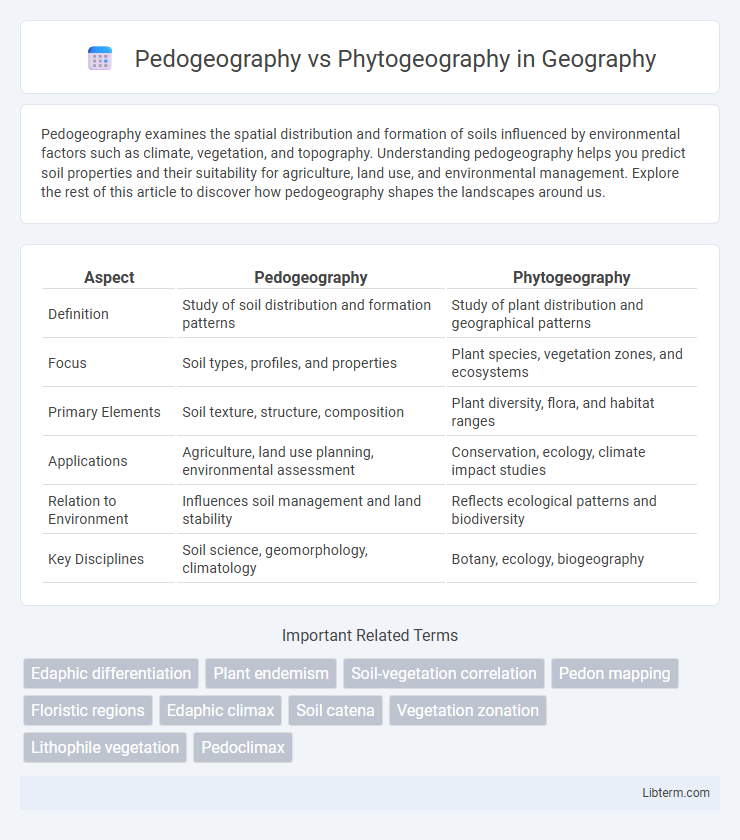Pedogeography examines the spatial distribution and formation of soils influenced by environmental factors such as climate, vegetation, and topography. Understanding pedogeography helps you predict soil properties and their suitability for agriculture, land use, and environmental management. Explore the rest of this article to discover how pedogeography shapes the landscapes around us.
Table of Comparison
| Aspect | Pedogeography | Phytogeography |
|---|---|---|
| Definition | Study of soil distribution and formation patterns | Study of plant distribution and geographical patterns |
| Focus | Soil types, profiles, and properties | Plant species, vegetation zones, and ecosystems |
| Primary Elements | Soil texture, structure, composition | Plant diversity, flora, and habitat ranges |
| Applications | Agriculture, land use planning, environmental assessment | Conservation, ecology, climate impact studies |
| Relation to Environment | Influences soil management and land stability | Reflects ecological patterns and biodiversity |
| Key Disciplines | Soil science, geomorphology, climatology | Botany, ecology, biogeography |
Introduction to Pedogeography and Phytogeography
Pedogeography studies the spatial distribution and properties of soils influenced by factors like climate, parent material, and topography, essential for understanding land use and agricultural potential. Phytogeography examines the geographic distribution of plant species and ecosystems, analyzing the impacts of environmental conditions and evolutionary history on vegetation patterns. Both disciplines interrelate by linking soil characteristics with plant distribution to assess ecosystem dynamics and landscape evolution.
Historical Development of Both Disciplines
Pedogeography and phytogeography originated in the 19th century as distinct branches of geographical science focused on soil and plant distribution, respectively. Pedogeography developed through the work of early soil scientists like Vasily Dokuchaev, who emphasized the relationship between soils and environmental factors, while phytogeography evolved from botanical studies by Alexander von Humboldt, who mapped plant species in relation to climate and terrain. Both disciplines advanced through increased field research and integration of ecological principles, forming foundations for modern environmental and biogeographical sciences.
Core Concepts and Definitions
Pedogeography examines the spatial distribution and formation of soils, emphasizing soil properties, classification, and environmental interactions within geographic contexts. Phytogeography studies the geographic distribution of plant species and vegetation patterns, focusing on factors influencing plant habitats, biomes, and ecological zones. Both disciplines analyze spatial patterns but differ in their core subjects: pedogeography centers on soil, while phytogeography concentrates on plant life and vegetation distributions.
Methodological Approaches in Pedogeography
Pedogeography employs soil mapping, sampling, and classification techniques to analyze spatial distribution and properties of soils, integrating geostatistical models and remote sensing data for detailed terrain analysis. It prioritizes the study of soil genesis and morphology using field surveys combined with laboratory soil profile analysis to understand pedogenic processes within geographic contexts. These methodological approaches contrast with phytogeography's focus on vegetation distribution patterns through botanical surveys and ecological niche modeling.
Methodological Approaches in Phytogeography
Phytogeography employs quantitative methods such as GIS mapping, remote sensing, and spatial statistics to analyze plant distribution patterns and their environmental determinants. It integrates ecological niche modeling and multivariate analysis to assess species-environment relationships and predict vegetation shifts under climate change scenarios. These methodological approaches contrast with pedogeography, which primarily focuses on soil classification and morphology using field sampling and laboratory analyses.
Key Differences Between Pedogeography and Phytogeography
Pedogeography studies the spatial distribution and formation of soils influenced by geological, climatic, and biological factors, while phytogeography focuses on the geographic distribution of plant species and vegetation patterns. Pedogeography emphasizes soil properties, processes like weathering and humus formation, and their relation to landforms, whereas phytogeography analyzes plant community types, biodiversity, and ecological zones based on climatic and environmental variables. Key differences include their primary focus--edaphic factors in pedogeography versus botanical factors in phytogeography--and the scale of analysis, with pedogeography concentrating on soil-landscape relationships and phytogeography on vegetation biogeography.
Interactions Between Soil and Plant Distribution
Pedogeography studies soil formation, distribution, and properties while phytogeography examines plant distribution patterns across regions. The interaction between soil and plant distribution is crucial, as soil texture, nutrient content, and pH directly influence vegetation types, growth rates, and biodiversity. Understanding these mutual influences enables accurate predictions of ecosystem dynamics and guides sustainable land management practices.
Applications in Environmental and Ecological Studies
Pedogeography, the study of soil distribution and formation, provides critical insights into soil-plant interactions and land management strategies, aiding in erosion control and sustainable agriculture. Phytogeography examines the spatial distribution of plant species, essential for biodiversity conservation, habitat restoration, and predicting vegetation shifts due to climate change. Integrating pedogeography and phytogeography enhances environmental and ecological studies by linking soil characteristics with vegetation patterns to optimize ecosystem management and conservation planning.
Challenges and Future Directions
Pedogeography faces challenges in mapping soil diversity due to its dynamic nature influenced by climate, topography, and anthropogenic activities, necessitating advanced geospatial technologies and machine learning integration for precise soil characterization. Phytogeography struggles with predicting plant distribution shifts under climate change, prompting the development of high-resolution climate models and genomic tools to assess species adaptation and migration patterns. Future directions in both fields emphasize interdisciplinary approaches combining remote sensing, big data analytics, and ecological modeling to enhance understanding of soil-plant interactions and support sustainable land management.
Conclusion: Integrating Pedogeography and Phytogeography
Integrating Pedogeography and Phytogeography enhances understanding of soil-vegetation interactions critical for ecosystem management and conservation. Mapping soil properties alongside plant distributions reveals patterns of nutrient cycling, habitat suitability, and environmental stress responses. This holistic approach supports sustainable land use planning and biodiversity preservation by linking pedological and botanical spatial dynamics.
Pedogeography Infographic

 libterm.com
libterm.com